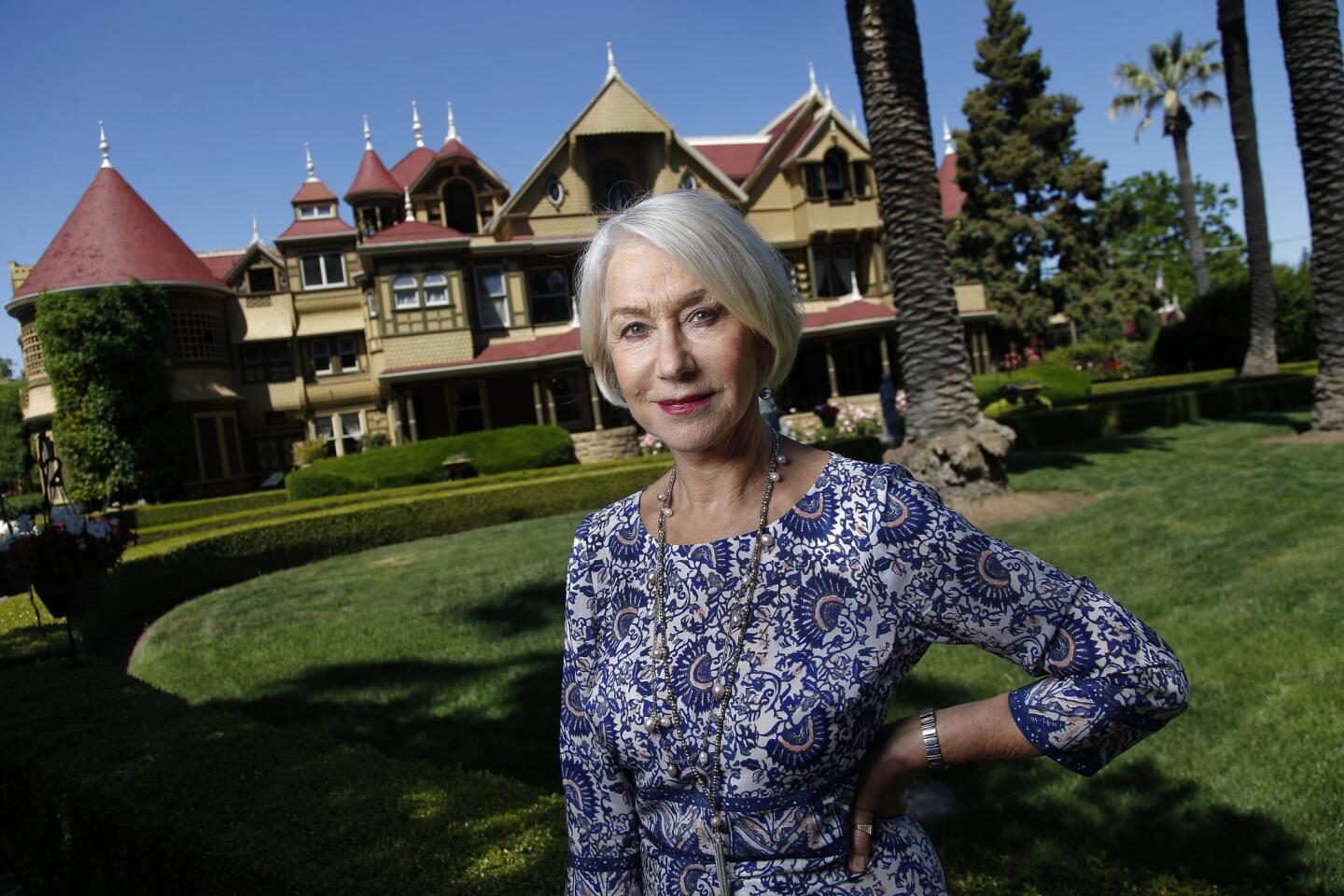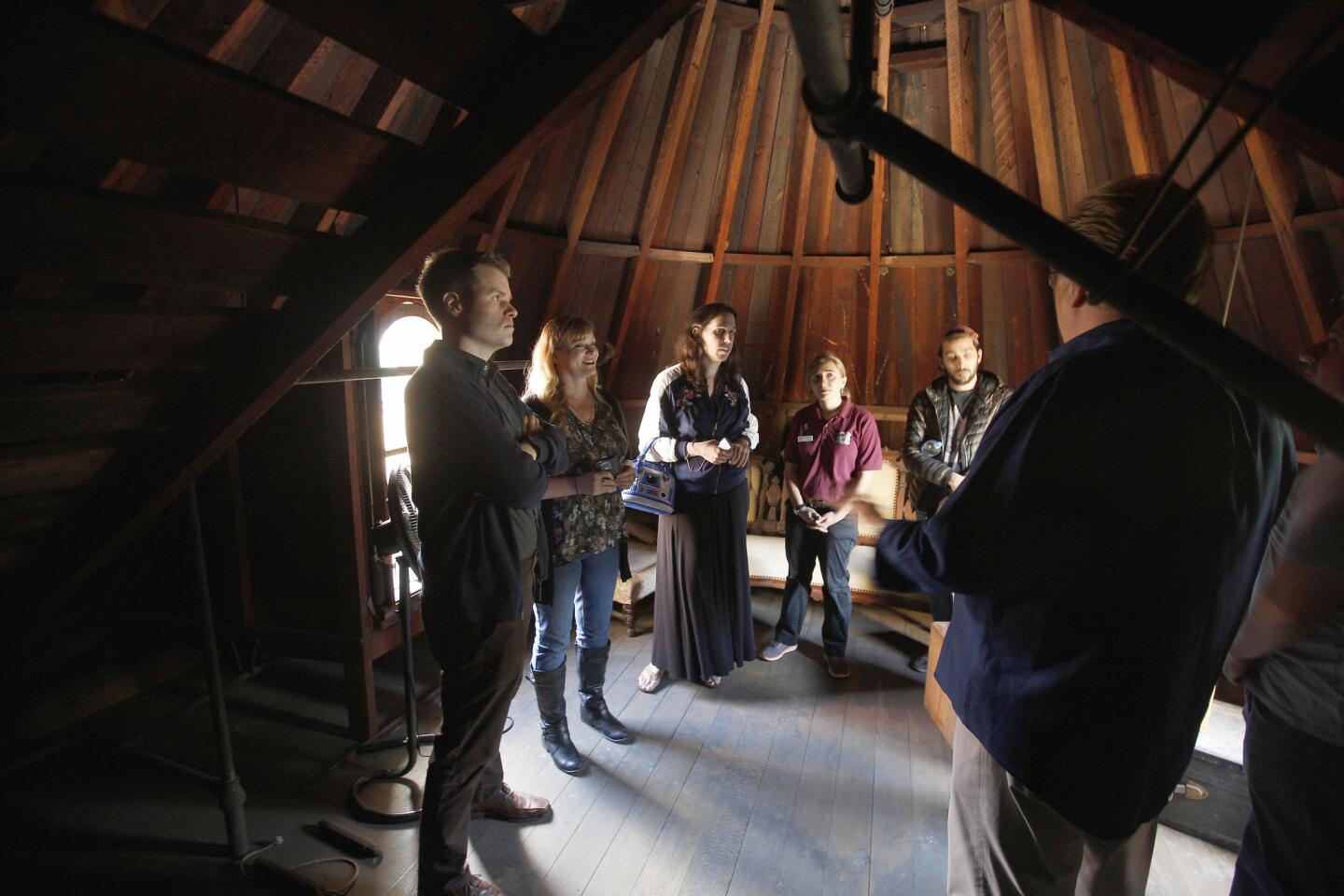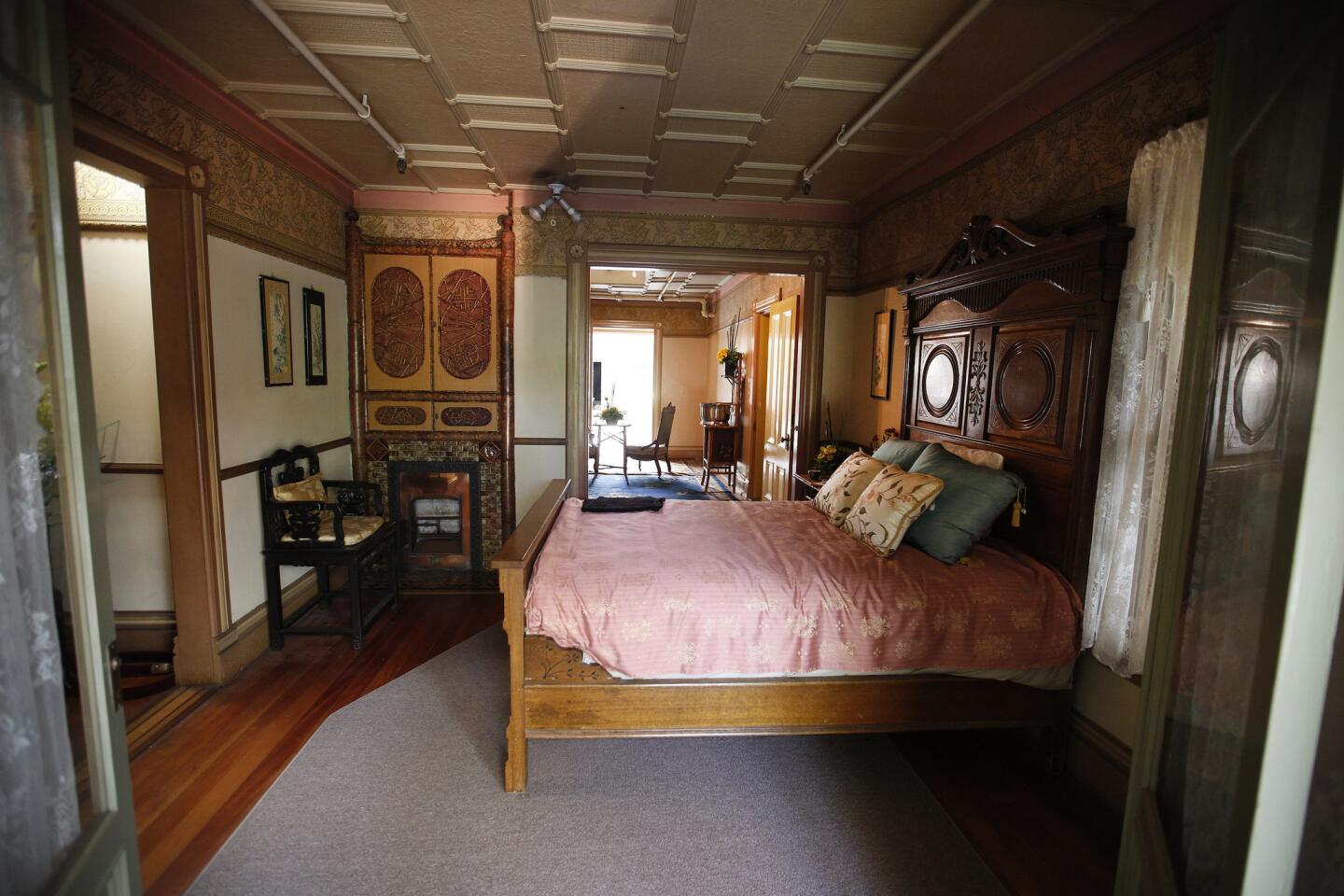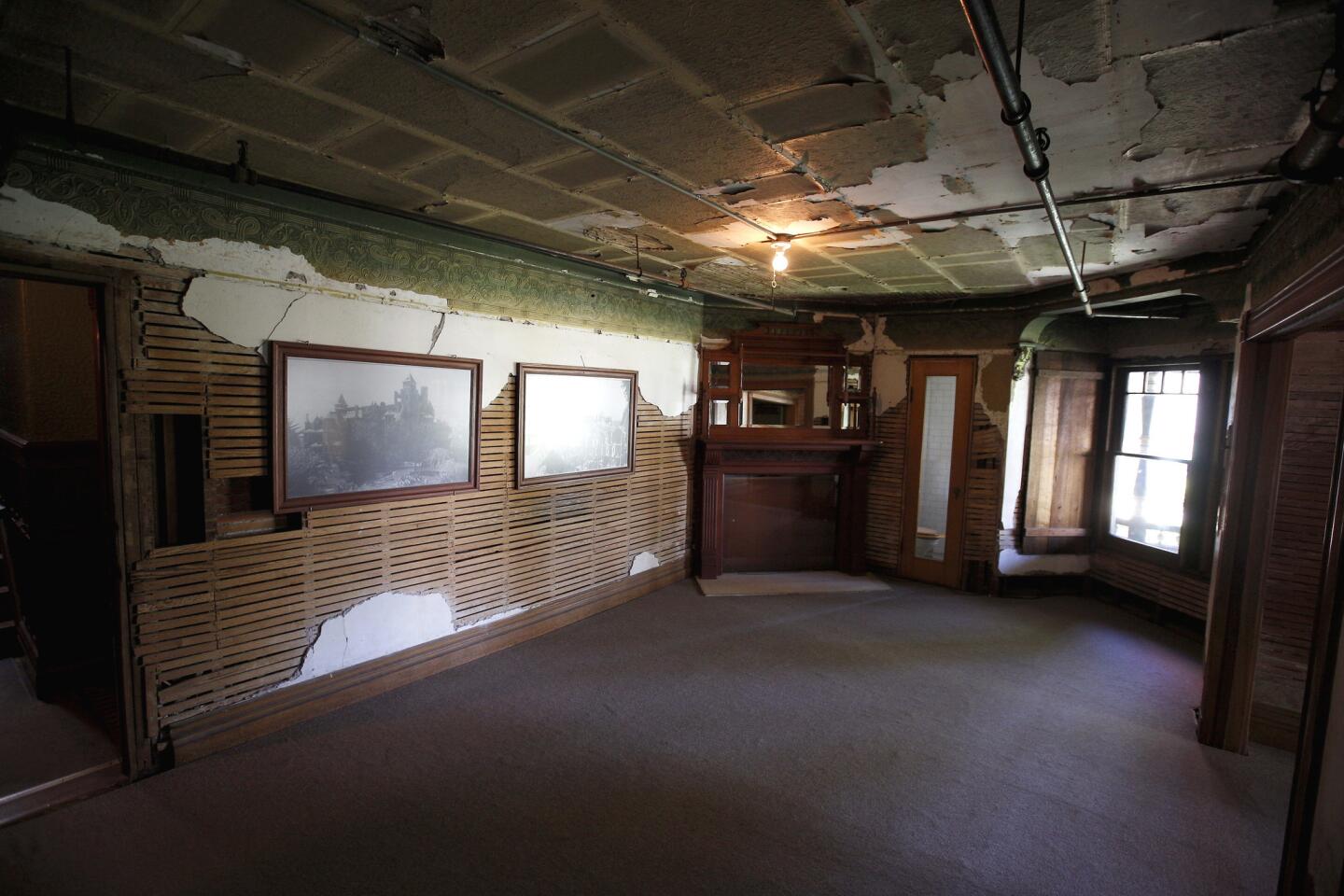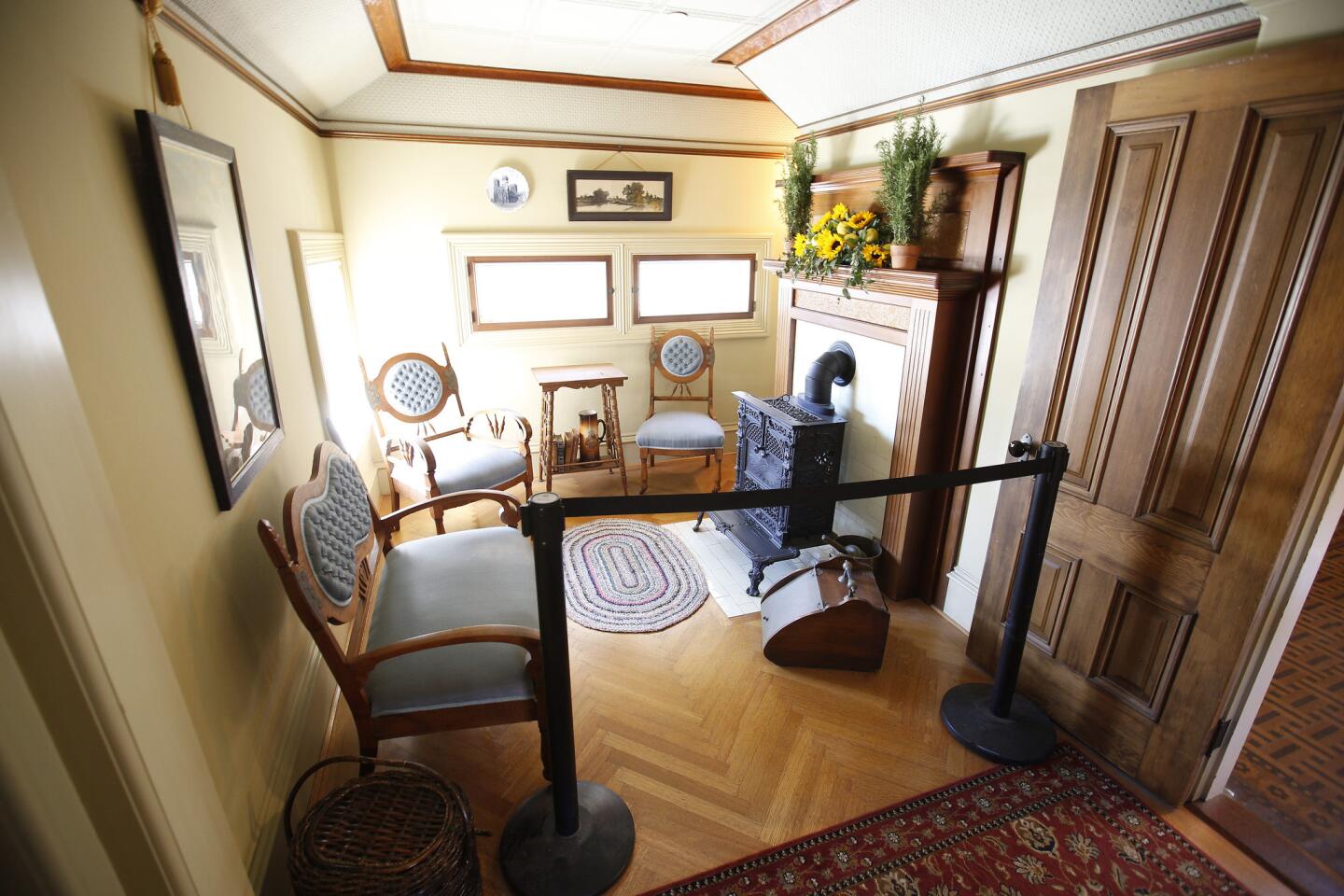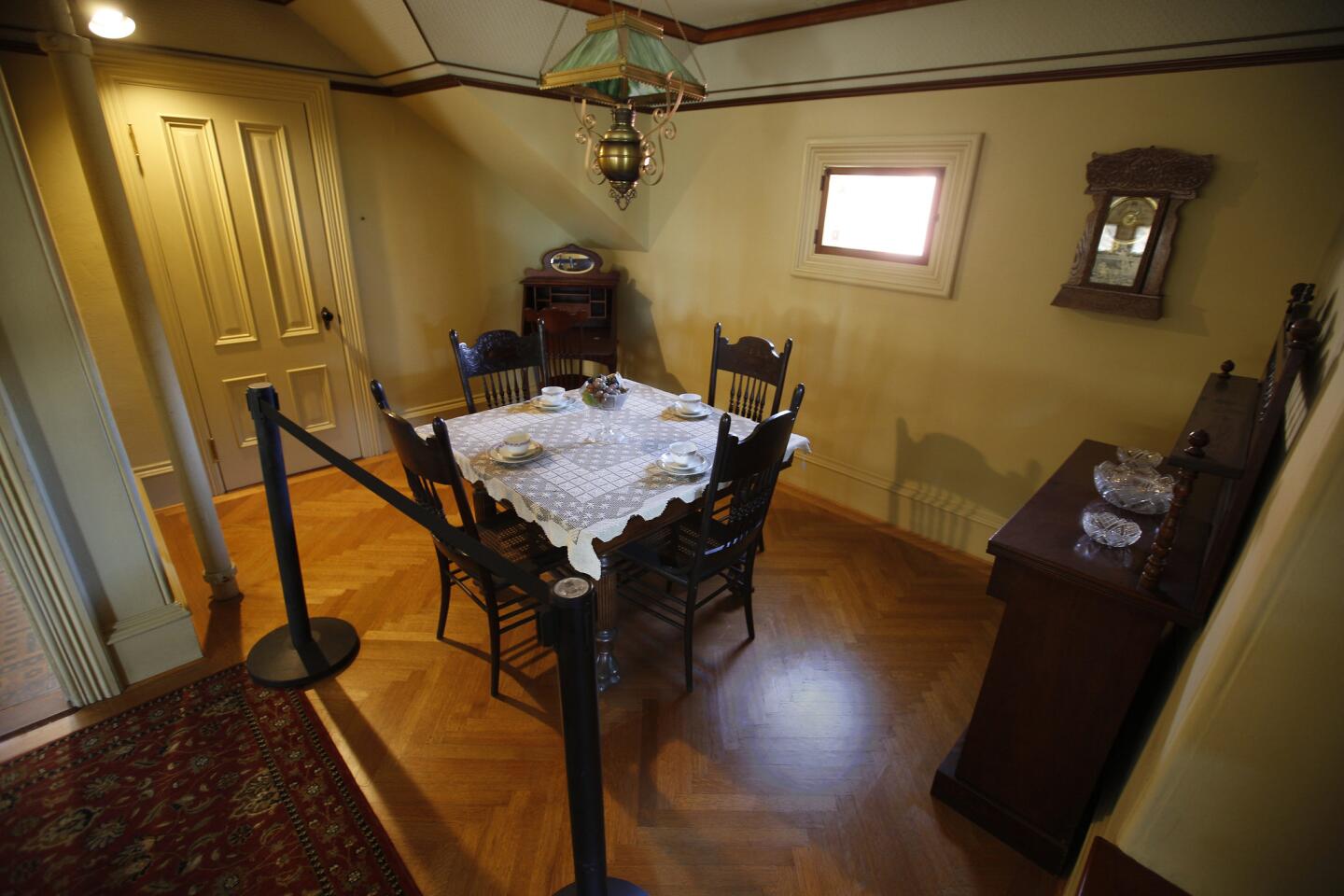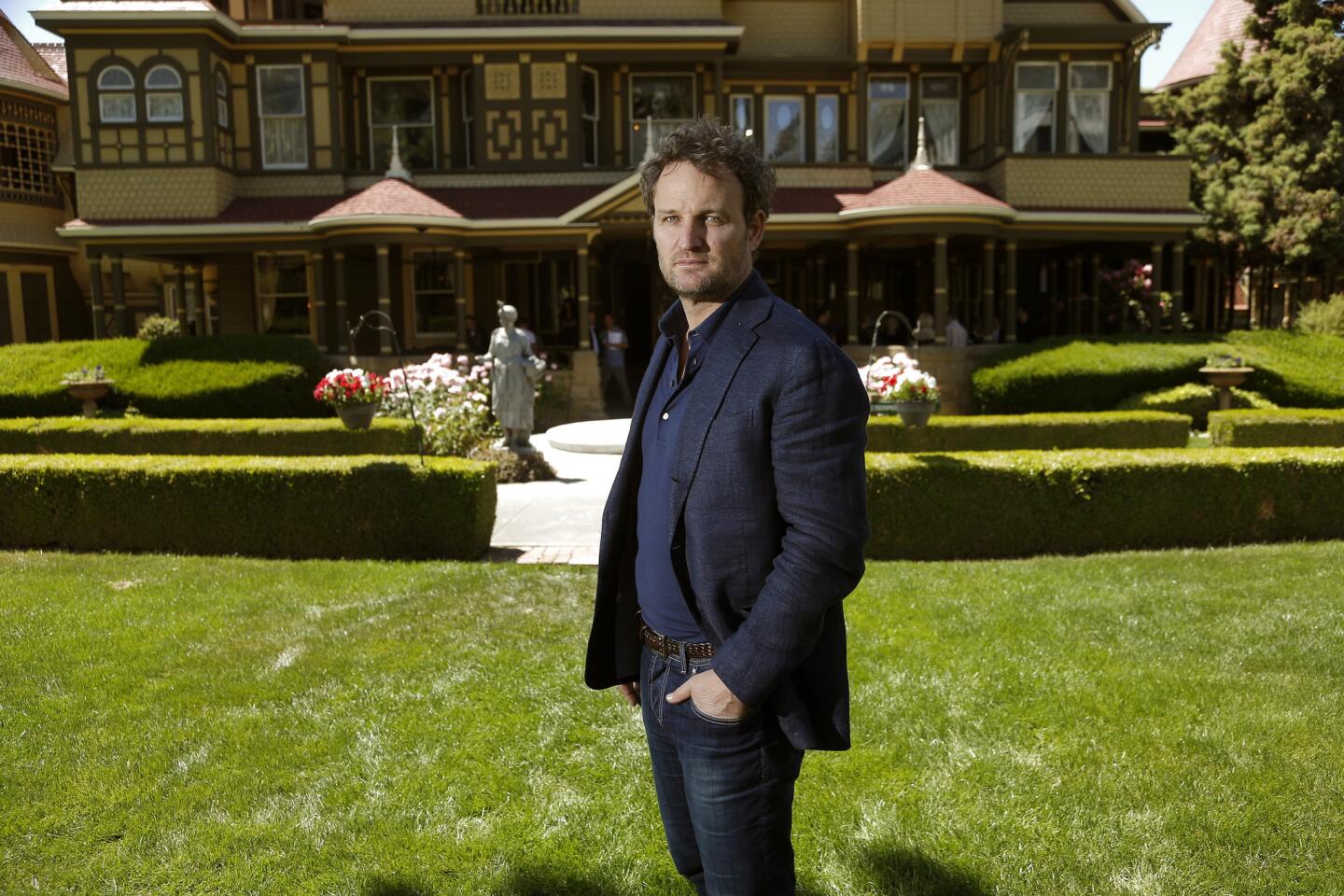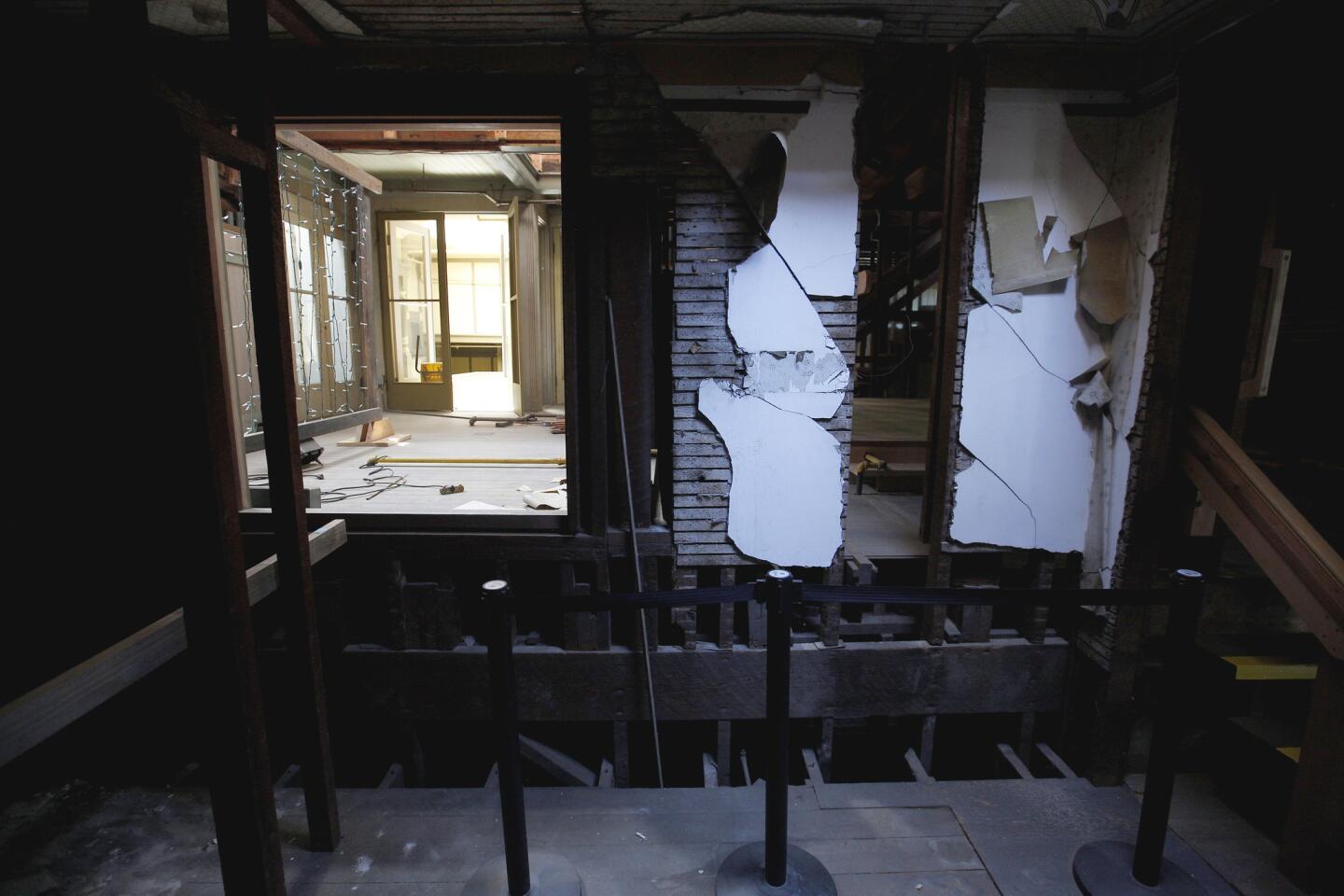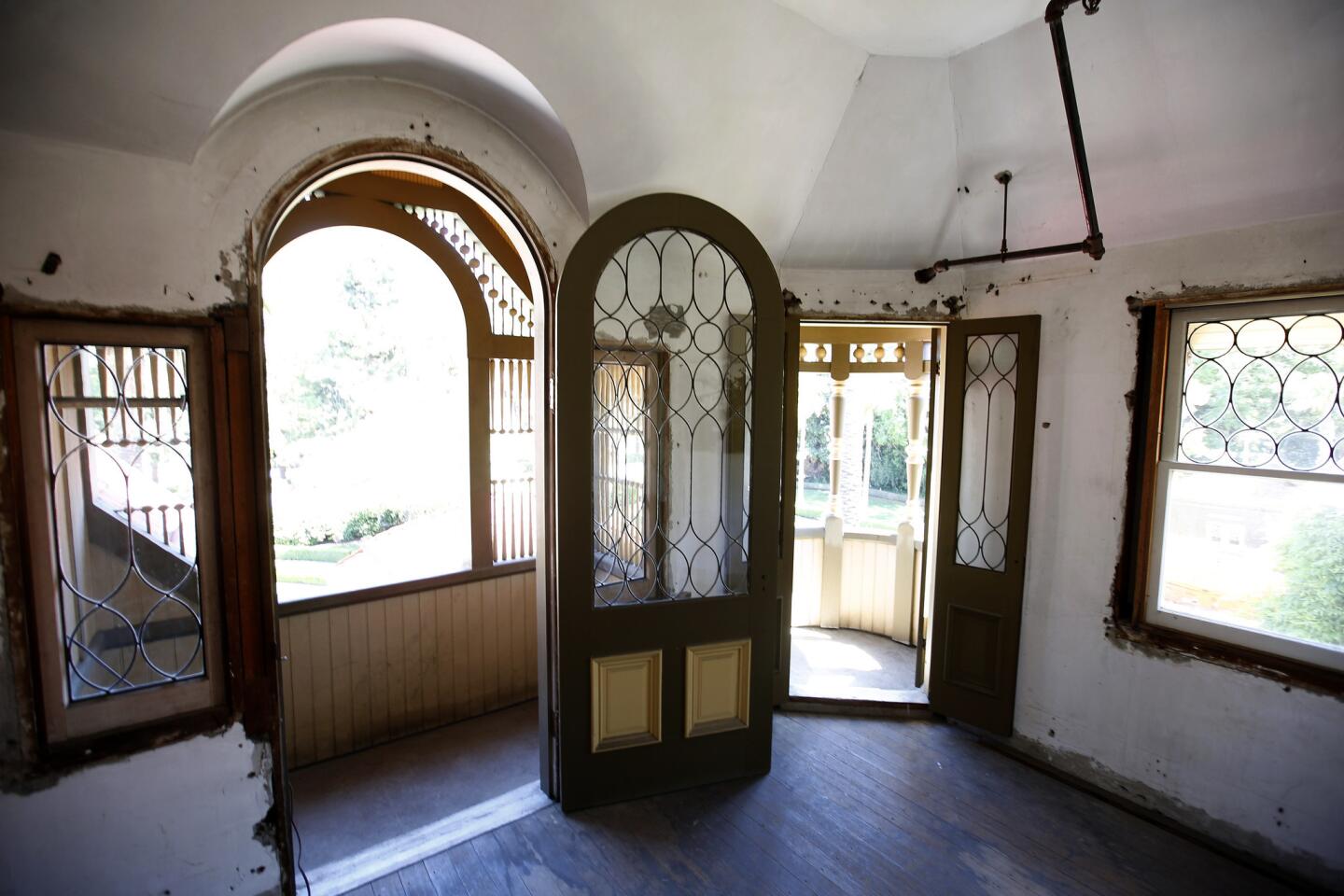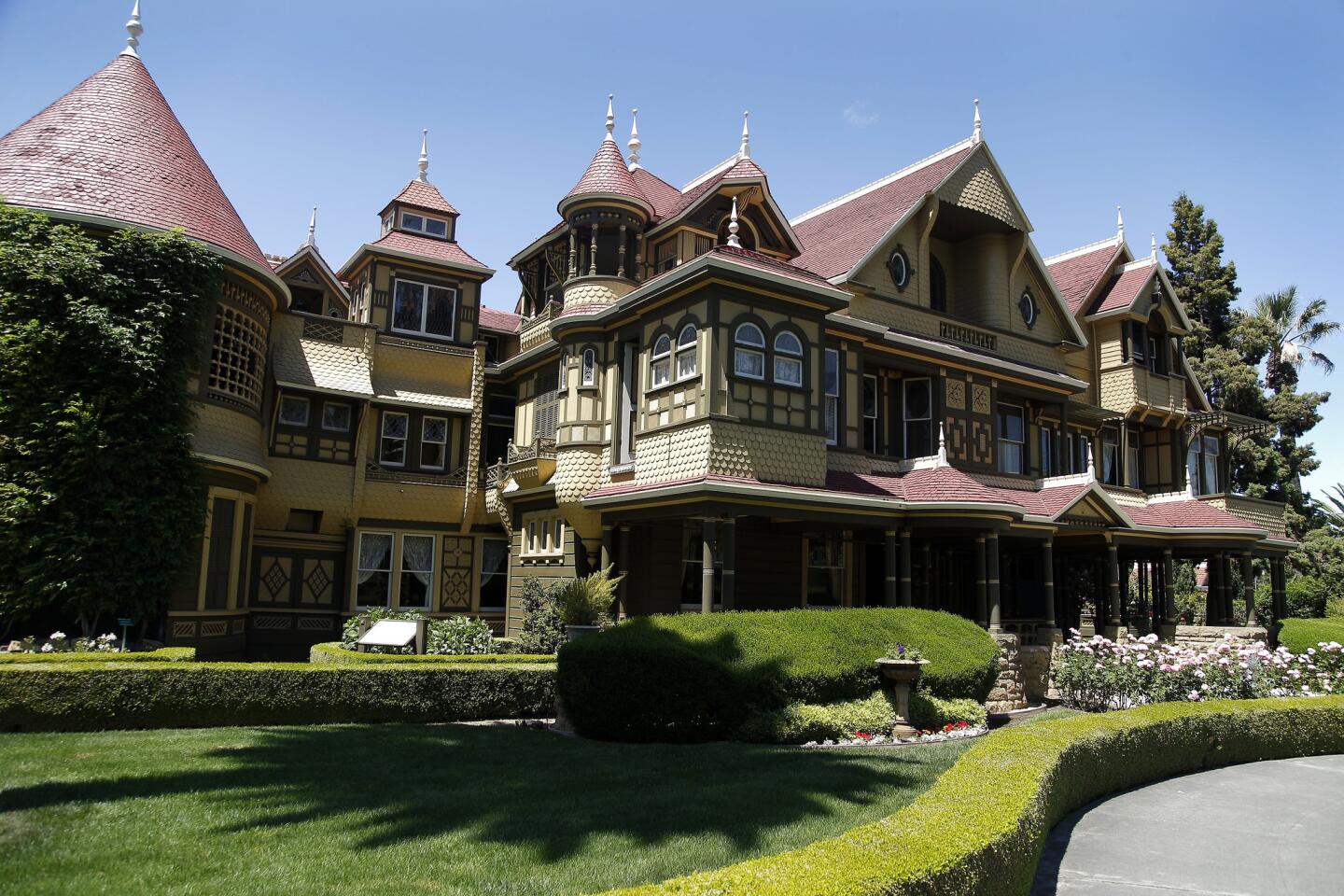California Journal: Guns, ghosts and guilt: Helen Mirren portrays the widow whose Winchester Mystery House defies logic
- Share via
Reporting from San Jose — It’s not mysterious, but it is a little strange to be sitting across from Helen Mirren in the not-so-grand “grand ballroom” of the Winchester Mystery House, a famously rambling and chaotic Victorian architectural marvel that is the antithesis of the sleek Silicon Valley aesthetic that has grown up around it.
Mirren is about to wrap shooting on “Winchester,” an Australian-made feature film in which she portrays Sarah Winchester, heir to the magnificent rifle fortune. Most of the filming was done in Melbourne, but the crew is here for some critical exterior shots. Winchester spent decades creating this extraordinary mansion, which, upon her death in 1922, became one of California’s first roadside attractions.
The stories surrounding Winchester’s construction compulsion are as entertaining as they are contrived: A famous Boston spiritualist told her to keep building to placate the tormented spirits of those killed by Winchester rifles. Or, the sound of hammers could never stop, lest she would die. Or, she was an architect manqué, whose construction oddities like the “staircase to nowhere” were simply the result of a lack of formal training.
The definitive truth will probably never be known, as there is little record of her endeavor besides a scattering of letters at Stanford University and San Jose’s historical archives. Only two photographs of her exist: one as a chubby-cheeked young woman in her 20s, the other as a stern widow in black Victorian garb sitting in a horse-drawn carriage in front of her mansion.
Every once in awhile, a distant relative shows up, but none has been able to produce family photographs or other memorabilia that might help answer the enduring questions about Winchester’s motivations.
“There are many understandings of her,” said Mirren, who visited the house for the first time last week. “Was she a Rosicrucian? Was she a straight-down-the-line Christian? Was she haunted? Was she crazy?”
This film, directed by Australian identical twins, Michael and Peter Spierig (who were hovering in the house like animated spirits), takes a decidedly supernatural tack, undoubtedly the most entertaining version of Winchester’s unusual life.
Mirren’s co-star, Jason Clarke, plays an invented character, Eric Price, a psychiatrist sent to the mansion by the Winchester Rifle Co. to declare Winchester insane in order to wrest back control of the company.
“Eric thinks there is a compulsiveness, a disorder, and tries to get to the cause of that,” Clarke said. “It’s a cycle; you continually build, and are paying the check with the very thing you are trying to run away from, which is the cause of your grief.”
Likewise, said Mirren, who likes shooting guns for target practice or the movies, but does not understand the American fixation with weapons.
“If you have made a fortune out of death, you have to pay the price, a psychological price and a spiritual price. And I can only imagine that people who make fortunes to this day from selling armaments have pause at some point, especially if they are Christians: ‘Am I going to pay?’”
::
Sarah Lockwood Pardee was born in 1840 and married into the Winchester family at age 22. In 1866, her father-in-law, Oliver Winchester, founded the Winchester Repeating Arms Co. in New Haven, Conn., which manufactured “the rifle that won the West.”
The same year Oliver founded the company that would make his family rich, Sarah gave birth to her only child, a daughter, who died at six weeks. When Sarah’s husband, William, died in 1881, she inherited 50% of the rifle company — about $20 million at that point — and moved west to be closer to her own family.
First, she landed in San Francisco, but the fog and cold aggravated her rheumatoid arthritis, so she bought 161 acres in the sunny Santa Clara Valley, an agricultural area filled with plum and apricot and walnut orchards. In 1884, she began construction on an eight-room farmhouse.
She and her late husband had supervised the construction of a large home in New Haven, said Winchester Mystery House historian Janan Boehme, who has worked at the house for most of the last 40 years. “I think Sarah was trying to repeat that experience by doing something they both loved.”
Architecturally, Boehme said, the Winchester house is not particularly important. “It’s a pretty average Queen Anne revival,” she said. “But it’s a really important part of our history. It’s a gem in our valley, and often, when people come to visit, they say, ‘Wow, I had no idea it was so nice.’”
Eventually, at a cost of about $5 million, the house grew to 160 rooms in 24,000 square feet. Then, in 1906, the great earthquake hit, toppling the seventh-story tower and buckling the top three floors. Winchester, who had a habit of sleeping in different rooms, was trapped in a bedroom for a time before her staff could find her.
Afterward, she sealed off the entire front of the house and left much of it in cosmetic disrepair. (The quake will be depicted in the film, which will be released in February. As will séances in the “witch’s cap,” a round turret at the front of the house, which may or may not have taken place.)
“It definitely got weirder over the years,” Boehme said. “After 1906, she herself said in a letter, ‘This house looks like it was built by a crazy person.’ So many things got boarded up, and were unfinished and unrepaired.”
Today, the house has a meticulously restored exterior and gardens. The interior, however, is a mishmash of original or restored decor. Some rooms were never finished, and some still have earthquake damage.
Boehme is skeptical about the tales of ghosts, spirits and ghouls. Winchester was reclusive, Boehme believes, because her hands were gnarled by arthritis and her teeth were so bad she required dentures.
Nor does she believe it likely that Winchester suffered from gun-driven guilt. “People didn’t have the massive guilt complex over guns that they have now,” she said. “They were a useful tool, something that people needed.”
Boehme says, based on her own reading, that Winchester kept building because she had a large staff, tons of money, and wanted to keep her workers gainfully employed. She was a philanthropist, having built a hospital in New Haven to treat and research tuberculosis, which killed her husband. (It still exists, as Yale New Haven Hospital’s Winchester Chest Clinic.)
“She had a social conscience and she did try to give back,” said Boehme, whose great-uncle worked for Winchester as an orchardist. “This house, in itself, was her biggest social work of all.”
::
I toured the home with film producer Tim McGahan and Winchester marketing director Tim O’Day. Our guide, Nicole Calande, said an apparition named Clyde often appears near the old coal chute in the basement where we stood. A committed anti-spiritualist, I had to suppress a giggle.
In any case, the real mystery about the house these days is who owns it and how much money it generates each year. Boehme said the home sold for about $150,000 in 1922, the year Winchester died, and opened soon thereafter to tourists. The same family that bought it then owns it now, she said, and does not wish to be named, nor to disclose the number of visitors who pass through each year, shelling out about $40 per visit.
The Santa Clara County assessor’s office has assessed the six-acre property in the heart of San Jose at a mere $1.15 million.
My sleuthing turned up three people who are principals of two companies that own the place, but no one returned my call. “They think it’s nobody’s business,” Boehme said.
Perhaps if I hold a séance, they will make themselves known.
Twitter: @AbcarianLAT
ALSO
An aggravating anniversary for Simi Valley, where a not-guilty verdict sparked the ’92 L.A. riots
Deadheads aren’t the only ones who’ll enjoy this ‘Long Strange Trip’
More to Read
Sign up for Essential California
The most important California stories and recommendations in your inbox every morning.
You may occasionally receive promotional content from the Los Angeles Times.
